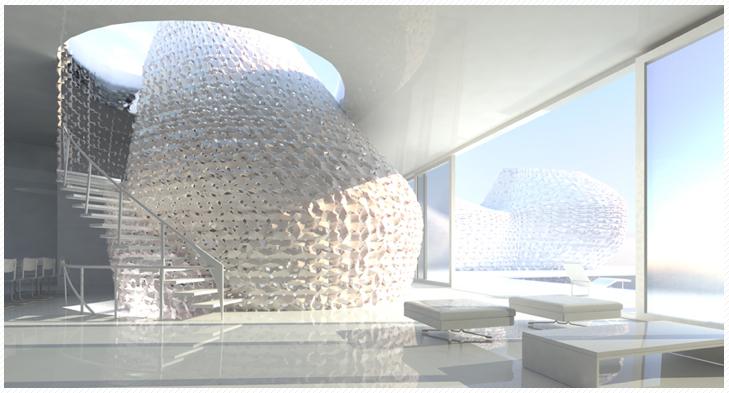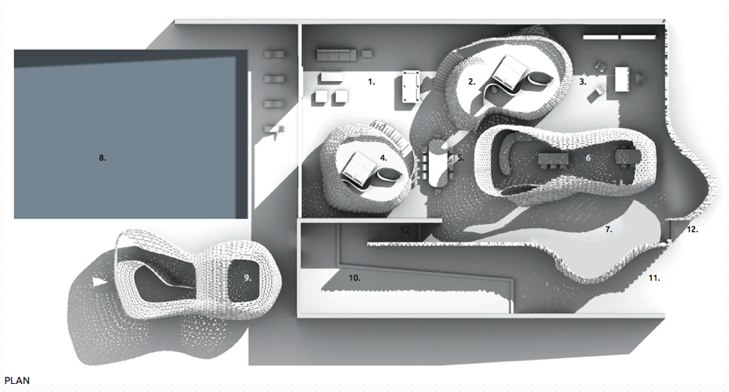The vision of 3D printed habitation seduces everyone who makes the imaginative leap from “hold” to “held.” We vault to new perspectives by scaling up the hand-cupped object — in our mind’s eye — to the object that “cups” an entire family. Voila! The 3D printed “house.”
Alas, “house” is a word too rectilinear. It doesn’t bespeak the bespoke. The “house’s” paucity of flex in design makes it staid and sterile — and strait-jacketing.
Could it be the straight-laced containers — in which we’ve been forced to live since our loss of the cave, the wigwam and the yurt — are insanity conducive? Non-amicable to human customized shapes and organic forms and fluid life-regimens that complement the human body — a supple and shape-shifting object without a single, physical, straight line.
Our first habitat — the womb — is ovoid: an infinite curve to egg on our analog desires. After that sinuous beginning, “straight” is the inorganic shortcut between to points with no algorithm for the beauty of meander.
Until habitation-scaled 3D printing, the escape from angled joins to amoebic continuities was impossible with commercial ROI.
Half a dozen organizations around the world have been competing over the last year or two, to claim the bragging rights to 3D printed-house “firsts.” (See 3DPI’s story on the Amsterdam Canal House — one of the leading contenders in this hotting-up, 3D printed habitation contest. Or, our earlier 3DP-housing piece on the University of Southern California’s “Robotic Building Construction Using Contour Crafting.” Or, for mind — and body! — bending, check out our report on the integrated 3D printing of “Small Transportable Living” in a 50-foot square variation of a mobile mini-house.)
Now, we have another Additive-Manufactured housing project — designed, managed and made for Beijing clients — by the American design-house Emerging Objects Corp. of Oakland, CA. (Perhaps it’s natural for a country with the world’s largest population and a chronic need for new ways to scale habitation-output to meet demand for housing — of whatever kind — with 3D printing.)
Addressing that need head on, Emerging Objects calls itself a “MAKE-tank at the forefront of 3D printing architecture.”
The innovative Emerging Objects “house” in Beijing — “3D Printed House 1.0” — is a hybrid concept: in several creative senses of the phrase. First, it’s both right-angled and organically curved. The house plan could be seen as a group of gourds embedded in — and erupting out of — rectilinear slabs and planes. Second, the building process engages both local workers and construction management in Beijing and Emerging Objects “experts from afar” with the necessary innovative architectural designs, technological vision and new-maker/builder skill sets. And, third, the actual “house building” involves a mix of unusual building materials and “pierced-textures” treatments, e.g., cement polymers and crystallized, translucent salts.
Emerging Objects further explains that, “Our innovation lies in our unique approach to materials and sizes and our belief that 3D printing is the medium where good ideas become real. We provide 3D printing design, consultation and fabrication services and leverage our expertise in material development to help our customers create compelling designs that are unable to be achieved any other way.”
“3D Printed House 1.0” will ask its Beijing inhabitants to rethink how life is lived in innovative habitations. From people interaction to privacy to the practicality of furniture and closets…or not. It’s also an absolutely gorgeous art piece — and great art can be notoriously difficult to live with—let alone in. (See any number of masterpieces of architectural “art” by Frank Lloyd Wright.)
That said, Emerging Objects is advancing the art, science and habitability of 3D printing’s plane and line-breaking habitations. Humans abiding in “3D Printed House 9.0” may be able to get their minds “around” the new arc of living with a new art of habitation.




